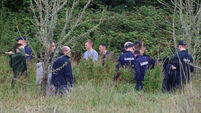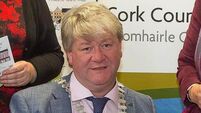Ann Murphy: The State is playing pass the parcel with missing children

A Garda search under way in Donabate, Dublin, amid an investigation into the circumstances of the disappearance and current whereabouts of a 7-year-old boy. Picture: Eamonn Farrell
Pass the parcel is no doubt a game that Kyran Durnin and the little boy missing in Dublin would have been familiar with — if they had lived long enough.
Instead, they are both presumed dead, with a murder investigation under way into Kyran’s case and a search ongoing in Donabate for the Dublin boy.
And while their childhoods are no more, games of pass the parcel seem to be what is being played out in relation to who knew or did what for the two boys.
Statements have been issued in recent days by the Department of Children and Tusla in relation to what has been done in terms of the two cases, including the referral of both cases to the National Review Panel.
Tusla has agreed to examine up to 38,000 files of children who had contact with the agency and whose cases were subsequently closed, in a bid to ensure there are not similar cases to the Dublin one which have not yet come to light.
According to the Department of Children, three quarters of the cases closed during the pandemic related to child welfare, rather than to child protection.
As a result, the review of the cases will be done on a risk-categorisation basis, involving administrative checks “to establish that these children are currently accounted for, are known to a relevant state service or state funded service, and that the service is aware they should contact Tulsa if they have any further concerns”.
The department says that “higher-risk category cases will involve more detailed review”.
The Dublin case and the murder investigation arising out of the disappearance of Kyran Durnin has led to questions about how two young children could disappear without a trace, without either being missed for several years.
Among those asking such questions is the Irish Association of Social Workers (IASW), which is now seeking a full statutory review to ensure that every aspect of the circumstances of the Dublin case are understood, to prevent further such cases in the future.
It also says the introduction of a “compulsory interagency working component”, expected with the “long-awaited review of the Child Care Act”, needs to be prioritised.
In a statement, the association said: “We strongly urge that services concerned with children become more integrated, with clear and appropriate sharing of information between professionals.
"Effective safeguarding depends on strong cooperation and communication across all relevant services.
“The IASW further calls on the State to ensure that all agencies with responsibilities for children are fully engaged and resourced to play their role in safeguarding and child protection.
"Protecting children is a shared responsibility that must involve health, education, social care, justice, and community supports working in genuine partnership.”
The association says there needs to be an examination of the “thresholds of harm that are being set by Tusla for the intake and monitoring of children referred to the service”.
The association adds: “This question also applies for the closing of a case. How is a child who was unsafe, or at risk of harm, now deemed safe, and who is deciding this and how is it managed?”
And it says: “We must learn from these cases and close the gaps. One child is one child too many.”
An study of reports of missing children in January found that there were 137 cases of people who had gone missing as children.
Since January, four of those children have been found.
However, there are now more than 140 cases of unsolved missing children cases in Ireland since 1977, including those of the Donabate boy and Kyran.
They also include well known cases including Philip Cairns from Dublin, Ciara Breen from Louth, and Mary Boyle from Donegal, Ireland’s longest-missing child who disappeared in 1977.
While an appeal about Kyran’s case now features on the Garda website’s missing persons section, his case and that of the Dublin case lay under the radar for years.
There too under the same radar lie the majority of those 140-plus children missing in Ireland for whom there are either Garda appeals or an Interpol yellow notice in place at present.
There was no big announcement in recent months when the cases of six of those missing young people were added to an international database seeking to progress the cases of missing people.
Just one of the cases relates to a child reported missing this year — an Iranian 15-year-old boy named Mahom Jafari who was last seen in Dublin in February.
Three others relate to children reported missing last year — Ersi Sala, 17, from Albania, Moagad Riad Sabaihi from Syria, and Ali Mohamed Abdulle from Somalia, who both recently turned 18.
Meanwhile, the other two are Salem Semere and Aelem Danieael, who were both in their mid teens when they went missing from the Red Cow Hotel in October 2020.
Currently, there are 68 missing persons cases from Ireland that are the subject of yellow notices which are published on the Interpol database.
They are among 10,783 live yellow notices on the database this week.
Last year, Interpol issued 2,687 such notices from across the world.
Cases where yellow notices are issued typically relate to victims of parental abductions, criminal abductions (kidnappings) or unexplained disappearances, according to Interpol.
The agency said: “The Yellow Notice can also be used to help identify a person who is unable to identify himself or herself.
"This is a valuable law enforcement tool that can increase the chances of a missing person being located, particularly if there is a possibility that the person might travel, or be taken, abroad.”
Efforts by the to get updated figures on the number of children in mainstream care who are currently missing failed.
The query had also sought information relating to how many children who arrived in Ireland under the international protection system and are separated from their families.
The query was submitted to Tusla on September 1 — a day before the news broke about the disappearance of the boy in Dublin, who, ironically, had been in the care of the State for a period of his short life.
Last Friday afternoon, the was told that a high volume of queries had been received by Tusla “and your response is being considered”.
The most recent figures were provided by minister for children, Norma Foley, in June, in response to a parliamentary question about children missing from State care.
She said that as of May 22, there were five young people who were in mainstream care who were reported as missing.
She said that on the same date, there were 32 children deemed as “Separated Children Seeking International Protection” reported as missing.
In what is now a stock reply for such questions, Ms Foley said that “some unaccompanied minors who go missing from care communicate their intention to travel on to other countries to join family members and some indicate that it was never their intention to remain in Ireland and leave soon after they arrive in the country.
"For those who do not subsequently make Tusla aware of their whereabouts, these young people are counted as missing and An Garda Siochána are notified accordingly.”
The area of missing children is a complex one, particularly given the different issues facing different age groups within the cohort of young people from babies to teenagers.
The 140-plus children known to be missing in Ireland are among an estimated 250,000 children who disappear every year in the EU.
Analysis of Ireland’s missing children by the has found that:
- 94 who disappeared between 2000 and 2010 remain missing;
- Of these, 40 Chinese teenagers went missing between October 2006 and December 2009, mainly from addresses in Dublin. Some of those disappearances were on the same day — for example, three were last seen in Dublin city centre on January 1, 2009;
- Some 11 young people disappeared from accommodation on South Richmond St, Dublin 2, between 2005 and 2009, while five who had been in accommodation on North Circular Rd, Dublin 7, disappeared on dates between 2005 and 2007.
According to the Missing Children Europe organisation, there are two dominant factors behind the statistics of Europe’s missing children — parental abductions and teenage runaways “because of adverse experiences”.
Indeed, among the Irish children on Interpol’s yellow notice list are two Co Louth brothers, Zayn and Kareem Mohamed, who were abducted by their father Ramy Gamal Maamoun Mohamed while they were on holidays in Cairo in April 2022.
Efforts by their mother Mandy Kelly to have them returned to Ireland have failed thus far.
The Missing Children Europe organisation is the European federation for missing and sexually exploited children.
In a report published in June, it highlighted that understanding why children go missing is difficult to establish because of the lack of comparable data from countries across Europe.
It pointed out that “the only report giving an estimation of the number of missing children across Europe dates back to 2013”.
As a result, the organisation receives data from different countries, including Ireland, relating to how many people access the 116 000 helpline set up to aid children at risk of going missing, and their families.
The report noted that that cases involving children in migration slightly rose in 2024, reaching 428 cases.
It also said that children reported missing in migration are more often boys than girls, “possibly because there are also more male asylum seekers and refugees”.
The report outlined that more than 40,000 unaccompanied minors applied for international protection in the EU in 2023.
The report continued: “These figures call attention to the grave risks faced by children on the move, including the escalating trafficking risks and the likelihood of disappearing.
In the same parliamentary question reply referenced earlier, Ms Foley mentioned the EU Migration and Asylum Pact which was passed last year.
The pact aims for a more coordinated migration management in the EU when it is implemented next year.
Ms Foley said: “It will, when implemented, in 2026, include children aged six and above to enhance protections for children and combat child trafficking and this will include biometric procedures and fingerprinting which will also assist in tracing Children Missing from Care.”
However, the IASW points out that there are challenges facing the area of child protection — not least the difficulties in recruiting and retaining staff in Tusla.
The association also highlights: “Coupled with a similar crisis in hiring and retaining social care workers to staff children’s residential centres, community supports, and special care places, all combine to create a huge strain on this already challenging and complex setting.
"Tusla’s role in this context is to care for and support our most vulnerable children and their families.”












